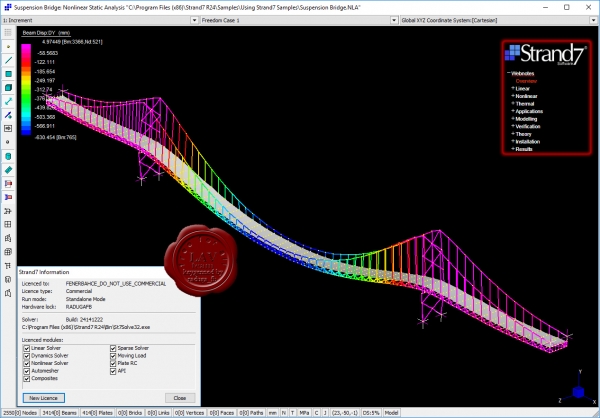| |
Strand7 R2.4.6 + Webnotes

Strand7's fully-integrated visual environment - combined with a suite of powerful solvers - gives you unparalleled functionality in a single application. Construct models, run analyses and investigate results simultaneously using a seamless interface. Strand7 lets you build models quickly. Create, delete and manipulate elements with a comprehensive set of tools, automatic meshing and unlimited undo. Organise a complicated model into a simple set of parts using the Group Tree. Define your own coordinate systems and beam cross-sections. Check mesh quality with aspect ratio and warping contours and free edge detection. Strand7 harnesses the power of Windows. Open multiple models at the same time. Cut-and-paste elements in 3D - even between models - and copy data to and from other Windows® programs. Import geometry data from IGES, ACIS, STEP and DXF files. Choose drawing styles and colours. Set the physical units for viewing and entering data. Dynamically rotate, pan and zoom in real time with a single click. Strand7 gives you a range of result options. Visualise results with contour maps, vector maps and X-Y graphs. Use the Peek tool to inspect result quantities at any point, directly on the model. View, sort and filter results with the Result Listings spreadsheet. Strand7 offers a full set of previewing and printing tools for documenting and reporting your work. Choose your own fonts, titleblocks and logos for a consistent, professional look across all your printing.
Extensive element library
- 1D: Beam, truss, pipe, spring, damper, connection, catenary cable and contact elements (2D and 3D)
- 2D: Plane stress, plane strain, plate/shell, 3D membrane, shear panel and axisymmetric elements
- 3D: Tetrahedral, wedge, pyramid and hexahedral elements
- Constraints: Rigid links, pinned links, master/slave links, sector-symmetry links, coupling links, attachment links
Comprehensive range of solvers
- Static: Linear, buckling, influence and non-linear (geometric, material and boundary non-linearity)
- Dynamic: Natural frequency, harmonic response and spectral response
- Transient: Linear and non-linear (geometric, material and boundary non-linearity)
- Heat transfer: Steady-state and transient (linear and non-linear)
Standard and specialist materials
- Linear and non-linear material models, including: Isotropic, orthotropic, anisotropic, soil, rubber, composite laminates and user-defined materials
Industry-standard data libraries
- Materials: Engineering properties for common materials - steel, timber, aluminium, concrete and glass
- Sections: Industry-standard cross-sections, including I-beams, tubes, channels and angles
|